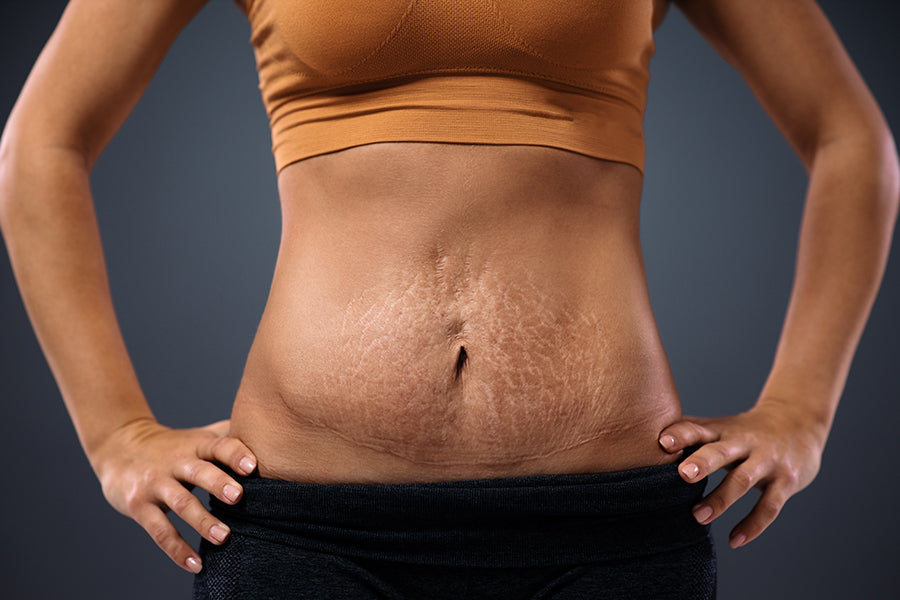So, you've just had a baby and are over the moon for the little one, but your deformed body is giving you anxiety? You look at all those fit and slim moms, which only worsens your situation. Don't worry; pregnancy is not easy on anyone! Every woman goes through tremendous challenges, and getting back in shape is one of them.
If your protruding belly is the cause of concern for you, here's all you need to know about it and eight amazing exercises to help your core muscles fall back into their right place. Keep reading to know why you even have the belly you loathe so much and how to fix it:
What is Diastasis Recti?
Diastasis recti (diastasis rectus abdominis or diastasis) marks the separation of the abs during and after pregnancy. The "six-pack abs" musculature at the front of your stomach, called the rectus abdominis, is stretched as your uterus expands during pregnancy.
This may lead to a permanent gap between the left and right sides that was once joined by a connective tissue band called the linea alba.
The linea alba typically heals and reconnects after childbirth, as it is highly elastic (like a rubber band). However, when the tissue loses its elasticity from being overstretched, the abdominals will not close as much as they should. This is known as diastasis recti.
If you have diastasis recti, your belly may protrude slightly above or below the belly button long after giving birth.
Related Article: How to Lose Belly Fat Naturally And Safely?
What Causes It?
Pregnancy often puts a strain on your abs. Your abdomen comprises left and right abdominal muscles, with a thin layer of connective tissue (linea alba) in the middle. They are pushed outwards during pregnancy to make room for the baby.
Diastasis recti occur when linea alba is overstretched and doesn't go back together afterward. The left and right sides of your abs stay apart, resulting in an "ab gap" or abdominal separation.
Diastasis recti usually develop during the third trimester. This is when the baby is growing fast, and there is a lot of pressure on the abdominals. Most people don't notice diastasis recti until after they have given birth.
Extremely common among pregnant women and new mothers. In fact, it affects 60% of people who give birth. It usually gets better on its own within eight weeks after delivery. However, about 40% of people with diastasis recti still have it six months after their baby is born.
Related Article: What is Caroline Girvan’s 15-Minute Dumbbell Abs Workout?
What are the Symptoms?
Common signs of diastasis recti are:
- A noticeable bulge in your stomach above or below the belly button.
- soft, jelly-type feeling around or below your belly button
- Coning or protruding upon contracting abs.
- Difficulty and discomfort while lifting slightly heavy objects, walking, or doing everyday chores.
- Painful sex.
- Hip pain
- Lower backache
- Distorted posture
- Leaking urine during abrupt actions like sneezing or coughing
- Weak core
- constipation
8 Best Diastasis Recti Exercises
Diastasis rectus is a common condition that goes unnoticed as women struggle to lose weight after giving birth. Your body will take time to come back to normal. There is no need to panic, but there are some things that can help you achieve your original shape postpartum, and these 8 exercises are one of those things:
1. Transverse Abdominal Breathing (TVA breathing) + Core Connection

- The entirety of this movement should come from your lower stomach.
- After inhaling for one second, slowly start exhaling.
- Exhale as much as you can over five seconds while simultaneously pushing your belly button toward the floor mat.
- Concentrate on squeezing your TVA muscles and posteriorly tilting your pelvis in the exhaled position.
2. Elevated Bent Knee V-Taps

- Starting by lying on your back with both legs bent at a 90-degree angle, squeezing your abdominal wall as tight as possible around your core.
- On the count of two, slowly open both legs to the sides while keeping them at that 90-degree bend - lowering your toes towards the outside of the mat.
- Once they lightly tap the mat, return to starting position again on a count of two, making sure to squeeze those inner thighs and knees together as you come back up.
- This movement should be slow and controlled throughout for the best results!
3. Elevated First Position Kick Outs

- You will need to press your low back firmly into the mat for this movement.
- Make sure to breathe in and wrap your abdominal wall as tightly as possible around your core.
- Once you have done that, bring both legs up, so they are at a 90-degree angle with respect to your hips.
- After that, position your feet such that they are touching heels together and toes pointing outwards away from each other, forming a "V."
- Now comes the fun part: on a 2-count, slowly kick both of the heels away from your body, and squeeze your inner thighs as your legs reach full extension.
- The full extension means that your legs should be fully extended outward without bending at the knees.
- Once you reach the maximum point for the kick, return to the starting position.
4. Lying Heel Tap + Leg Lift

- With your low back firmly pressed to the mat and your core engaged, tap or slide one heel away from your body.
- Then, raise your leg off the ground, returning to the starting position and keeping it straight throughout the movement.
5. Lying Bent Knee Pulls

- Firmly press your low back into the mat and suck in your stomach so that your abdominal wall is tight around your core.
- Then, pull one knee up towards your chest, hold for a 2-3 count, and switch legs.
6. Elevated Bent Knee March

- Lay on your back with your low back pressing into the mat and bring your legs to a 90-degree bend, ensuring that your abdominal wall is wrapped tightly around your core.
- To make it more difficult, keep them further away from your chest.
- Slowly alternate tapping one toe towards the ground and then return to starting position before tapping the other toe down.
- Do this movement slowly and with control throughout the entire set.
7. Elevated Leg Extension + Leg Drop

- Start by lying on your back with your low back flat against the mat and your abs pulled in tightly around your core.
- Bend your legs to a 90-degree angle, then extend one leg straight out.
- Slowly lower the extended leg towards the ground, then return to starting position.
- Repeat on the other side.
- This movement should be slow and controlled throughout.
8. Elevated Leg Extension + 2 Circles

- With your back pressed firmly into the mat and your abdominal muscles engaged, bring your legs to a 90-degree bend.
- Extend one leg straight out, then slowly draw two donut-shaped circles with the big toe of your extended leg.
- Return to the starting position, and repeat on the other side.
- This movement should be slow and controlled.
FAQs
1. Will diastasis recti ever go away?
It may seem hard soon after birth, but the condition disappears. With time and exercise, your muscles will return to their original place. You just need to stick to eating right and working out with special exercises.
2. What happens if you ignore diastasis recti?
With a new baby and all the exhaustion, it's easy to forget how your body looks, but trust me, you don't want to do that. If you become busy with a new baby and neglect your diastasis recti postpartum, it could result in back pain, weak core muscles, pelvic pain and weakness, and incontinence later on. To avoid this, continue to roll to one side after birth and avoid lurching forward.
3. What exercises should I not do with diastasis?
Diastasis recti can worsen with certain activities and exercises, like crunches, planks, ab twists, backward bends that stretch the abdominal area, or any type of heavy lifting activities that bulge the stomach. So be careful to avoid those movements.
4. Does diastasis recti get worse with age?
Diastasis Recti is a condition that causes the separation of abdominal muscles to widen over time. As the organs in the abdomen, such as the uterus and intestines, have less support in front, they begin to sag, which can cause intense lower back pain.
Summary
Although diastasis recti is a condition that primarily affects women who have recently given birth, it can also affect men and children. The good part is that there are exercises you can do to help improve your condition. TVA breathing + core connection, elevation bent knee v-taps, elevated first position kick outs, lying heel tap + leg lift, lying bent knee pulls, elevated bent knee march, elevated leg extension + leg drop, and elevated leg extension + 2 circles are all great exercises to try. If you are suffering from the symptoms of diastasis recti, don't hesitate to try these exercises.











